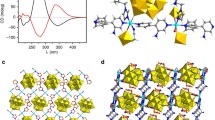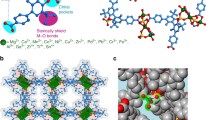Abstract
Metal-organic frameworks (MOFs) have achieved great success in the field of heterogeneous catalysis, however, it’s still challenging to design MOF catalysts with enhanced selectivity. Here, we demonstrated a combination strategy of metal design and ligand design on the enantioselectivity—that is the enantioselectivities of chiral MOF (CMOF) catalysts could be significantly enhanced by the rational choice of metal ions with higher electronegativities and introducing sterically demanding groups into the ligands. Four isostructural Ca-, Sr- and Zn-based CMOFs were prepared from enantiopure phosphono-carboxylate ligands of 1,1′-biphenol that are functionalized with 2,4,6-trimethyl- and 2,4,6-trifluoro-phenyl groups at the 3,3’-position. The uniformly distributed metal phosphonates along the channels could act as Lewis acids and catalyze the asymmetric transfer hydrogenation of heteroaromatic imines (benzoxazines and quinolines). Particularly, the Ca-based MOF 1 with 2,4,6-trimethyl groups at the substituents exhibited enhanced catalytic performance, affording the highest enantioselectivity (up to 97%). It is also the first report of the heterogeneous catalyst with chiral non-noble metal phosphonate active sites for asymmetric transfer hydrogenation reactions with Hantzsch ester as the hydrogen source. The catalyst design strategy demonstrated here is expected to develop new types of chiral materials for asymmetric catalysis and other chiral applications.

Similar content being viewed by others
References
Su, F.; Guo, Y. H. Advancements in solid acid catalysts for biodiesel production. Green Chem.2014, 16, 2934–2957.
Liang, J.; Liang, Z. B.; Zou, R. Q.; Zhao, Y. L. Heterogeneous catalysis in zeolites, mesoporous silica, and metal-organic frameworks. Adv. Mater.2017, 29, 1701139.
Chughtai, A. H.; Ahmad, N.; Younus, H. A.; Laypkov, A.; Verpoort, F. Metal-organic frameworks: Versatile heterogeneous catalysts for efficient catalytic organic transformations. Chem. Soc. Rev.2015, 44, 6804–6849.
Yadav, A.; Kanoo, P. Metal-organic frameworks as platform for Lewis-acid-catalyzed organic transformations. Chem.—Asian J.2019, 14, 3531–3551.
Wang, C.; Liu, D. M.; Lin, W. B. Metal-organic frameworks as a tunable platform for designing functional molecular materials. J. Am. Chem. Soc.2013, 135, 13222–13234.
Chen, X.; Peng, Y. W.; Han, X.; Liu, Y.; Lin, X. C.; Cui, Y. Sixteen isostructural phosphonate metal-organic frameworks with controlled Lewis acidity and chemical stability for asymmetric catalysis. Nat. Commun.2017, 8, 2171.
Chen, X.; Jiang, H.; Hou, B.; Gong, W.; Liu, Y.; Cui, Y. Boosting chemical stability, catalytic activity and enantioselectivity of metal-organic frameworks for batch and flow reactions. J. Am. Chem. Soc.2017, 139, 13476–13482.
Chen, X.; Jiang, H.; Li, X.; Hou, B.; Gong, W.; Wu, X. W.; Han, X.; Zheng, F. F.; Liu, Y.; Jiang, J. W. et al. Chiral phosphoric acids in metal-organic frameworks with enhanced acidity and tunable catalytic selectivity. Angew. Chem., Int. Ed.2019, 58, 14748–14757.
Li, Z. Y.; Peters, A. W.; Platero-Prats, A. E.; Liu, J.; Kung, C. W.; Noh, H.; DeStefano, M. R.; Schweitzer, N. M.; Chapman, K. W.; Hupp, J. T. et al. Fine-tuning the activity of metal-organic framework-supported cobalt catalysts for the oxidative dehydrogenation of propane. J. Am. Chem. Soc.2017, 139, 15251–15258.
Huang, N.; Yuan, S.; Drake, H.; Yang, X. Y.; Pang, J. D.; Qin, J. S.; Li, J. L.; Zhang, Y. M.; Wang, Q.; Jiang, D. L. et al. Systematic engineering of single substitution in zirconium metal-organic frameworks toward high-performance catalysis. J. Am. Chem. Soc.2017, 139, 18590–18597.
Johnson, J. A.; Petersen, B. M.; Kormos, A.; Echeverría, E.; Chen, Y. S.; Zhang, J. A new approach to non-coordinating anions: Lewis acid enhancement of porphyrin metal centers in a zwitterionic metal-organic framework. J. Am. Chem. Soc.2016, 138, 10293–10298.
Dubey, R. J. C.; Comito, R. J.; Wu, Z. W.; Zhang, G. H.; Rieth, A. J.; Hendon, C. H.; Miller, J. T.; Dinca, M. Highly stereoselective heterogeneous diene polymerization by Co-MFU-4l: A single-site catalyst prepared by cation exchange. J. Am. Chem. Soc.2017, 139, 12664–12669.
Gedrich, K.; Heitbaum, M.; Notzon, A.; Senkovska, I.; Fröhlich, R.; Getzschmann, J.; Mueller, U.; Glorius, F.; Kaskel, S. A family of chiral metal-organic frameworks. Chem.—Eur. J.2011, 17, 2099–2106.
Ma, L. Q.; Falkowski, J. M.; Abney, C.; Lin, W. B. A series of isoreticular chiral metal-organic frameworks as a tunable platform for asymmetric catalysis. Nat. Chem.2010, 2, 838–846.
Tan, C. X.; Han, X.; Li, Z. J.; Liu, Y.; Cui, Y. Controlled exchange of achiral linkers with chiral linkers in Zr-based UiO-68 metal-organic framework. J. Am. Chem. Soc.2018, 140, 16229–16236.
Gong, W.; Chen, X.; Jiang, H.; Chu, D. D.; Cui, Y.; Liu, Y. Highly stable Zr(IV)-based metal-organic frameworks with chiral phosphoric acids for catalytic asymmetric tandem reactions. J. Am. Chem. Soc.2019, 141, 7498–7508.
Banerjee, M.; Das, S.; Yoon, M.; Choi, H. J.; Hyun, M. H.; Park, S. M.; Seo, G.; Kim, K. Postsynthetic modification switches an achiral framework to catalytically active homochiral metal-organic porous materials. J. Am. Chem. Soc.2009, 131, 7524–7525.
Falkowski, J. M.; Sawano, T.; Zhang, T.; Tsun, G.; Chen, Y.; Lockard, J. V.; Lin, W. B. Privileged phosphine-based metal-organic frameworks for broad-scope asymmetric catalysis. J. Am. Chem. Soc.2014, 136, 5213–5216.
Ji, P. F.; Feng, X. Y.; Oliveres, P.; Li, Z.; Murakami, A.; Wang, C.; Lin, W. B. Strongly Lewis acidic metal-organic frameworks for continuous flow catalysis. J. Am. Chem. Soc.2019, 141, 14878–14888.
Ji, P. F.; Drake, T.; Murakami, A.; Oliveres, P.; Skone, J. H.; Lin, W. B. Tuning Lewis acidity of metal-organic frameworks via perfluorination of bridging ligands: Spectroscopic, theoretical, and catalytic studies. J. Am. Chem. Soc.2018, 140, 10553–10561.
Zhang, Y.; Guo, J.; Shi, L.; Zhu, Y. F.; Hou, K.; Zheng, Y. L.; Tang, Z. Y. Tunable chiral metal organic frameworks toward visible light-driven asymmetric catalysis. Sci. Adv.2017, 3, e1701162.
Parmar, D.; Sugiono, E.; Raja, S.; Rueping, M. Complete field guide to asymmetric BINOL-phosphate derived Brønsted acid and metal catalysis: History and classification by mode of activation; Brønsted acidity, hydrogen bonding, ion pairing, and metal phosphates. Chem. Rev.2014, 114, 9047–9153.
Parra, A.; Reboredo, S.; Castro, A. M. M.; Alemán, J. Metallic organophosphates as catalysts in asymmetric synthesis: A return journey. Org. Biomol. Chem.2012, 10, 5001–5020.
Foubelo, F.; Yus, M. Catalytic asymmetric transfer hydrogenation of imines: Recent advances. Chem. Rec.2015, 15, 907–924.
Zheng, C.; You, S. L. Transfer hydrogenation with Hantzsch esters and related organic hydride donors. Chem. Soc. Rev.2012, 41, 2498–2518.
Rueping, M.; Antonchick, A. P.; Theissmann, T. Remarkably low catalyst loading in Brønsted acid catalyzed transfer hydrogenations: Enantioselective reduction of benzoxazines, benzothiazines, and benzoxazinones. Angew. Chem., Int. Ed.2006, 45, 6751–6755.
Zhang, Y. L.; Zhao, R.; Bao, R. L. Y.; Shi, L. Highly enantioselective SPINOL-derived phosphoric acid catalyzed transfer hydrogenation of diverse C=N-containing heterocycles. Eur. J. Org. Chem.2015, 2015, 3344–3351.
Tu, X. F.; Gong, L. Z. Highly enantioselective transfer hydrogenation of quinolines catalyzed by gold phosphates: Achiral ligand tuning and chiral-anion control of stereoselectivity. Angew. Chem., Int. Ed.2012, 51, 11346–11349.
Bleschke, C.; Schmidt, J.; Kundu, D. S.; Blechert, S.; Thomas, A. A chiral microporous polymer network as asymmetric heterogeneous organocatalyst. Adv. Synth. Catal.2011, 353, 3101–3106.
Kundu, D. S.; Schmidt, J.; Bleschke, C.; Thomas, A.; Blechert, S. A microporous binol-derived phosphoric acid. Angew. Chem., Int. Ed.2012, 51, 5456–5459.
Zhang, Z. X.; Ji, Y. R.; Wojtas, L.; Gao, W. Y.; Ma, S. Q.; Zaworotko, M. J.; Antilla, J. C. Two homochiral organocatalytic metal organic materials with nanoscopic channels. Chem. Commun.2013, 49, 7693–7695.
Xie, J. H.; Zhu, S. F.; Zhou, Q. L. Transition metal-catalyzed enantioselective hydrogenation of enamines and imines. Chem. Rev.2011, 111, 1713–1760.
Arai, N.; Saruwatari, Y.; Isobe, K.; Ohkuma, T. Asymmetric hydrogenation of quinoxalines, benzoxazines, and a benzothiazine catalyzed by chiral ruthenabicyclic complexes. Adv. Synth. Catal.2013, 355, 2769–2774.
Wang, C.; Li, C. Q.; Wu, X. F.; Pettman, A.; Xiao, J. L. pH-regulated asymmetric transfer hydrogenation of quinolines in water. Angew. Chem., Int. Ed.2009, 48, 6524–6528.
Núñez-Rico, J. L.; Vidal-Ferran, A. [Ir(P-OP)]-catalyzed asymmetric hydrogenation of diversely substituted C=N-containing heterocycles. Org. Lett.2013, 15, 2066–2069.
Fleischer, S.; Zhou, S. L.; Werkmeister, S.; Junge, K.; Beller, M. Cooperative iron-Brønsted acid catalysis: Enantioselective hydrogenation of quinoxalines and 2H-1,4-benzoxazines. Chem.—Eur. J.2013, 19, 4997–5003.
Spek, A. L. Single-crystal structure validation with the program PLATON. J. Appl. Cryst.2003, 36, 7–13.
Chen, Z. P.; Zhou, Y. G. Asymmetric hydrogenation of heteroarenes with multiple heteroatoms. Synthesis2016, 48, 1769–1781.
Breuer, M.; Ditrich, K.; Habicher, T.; Hauer, B.; Keßeler, M.; Stürmer, R.; Zelinski, T. Industrial methods for the production of optically active intermediates. Angew. Chem., Int. Ed.2004, 43, 788–824.
Vitaku, E.; Smith, D. T.; Njardarson, J. T. Analysis of the structural diversity, substitution patterns, and frequency of nitrogen heterocycles among U.S. FDA approved pharmaceuticals. J. Med. Chem.2014, 57, 10257–10274.
Pearson, R. G. Absolute electronegativity and hardness: Application to inorganic chemistry. Inorg. Chem.1988, 27, 734–740.
Chen, S. M.; Wang, H. X.; Li, Z. J.; Wei, F. L.; Zhu, H.; Xu, S. Q.; Xu, J. X.; Liu, J. J.; Gebru, H.; Guo, K. Metallic organophosphate catalyzed bulk ring-opening polymerization. Polym. Chem.2018, 9, 732–742.
Wang, J.; Chen, M. W.; Ji, Y.; Hu, S. B.; Zhou, Y. G. Kinetic resolution of axially chiral 5- or 8-substituted quinolines via asymmetric transfer hydrogenation. J. Am. Chem. Soc.2016, 138, 10413–10416.
Zhao, D. B.; Glorius, F. Enantioselective hydrogenation of isoquinolines. Angew. Chem., Int. Ed.2013, 52, 9616–9618.
Alix, A.; Lalli, C.; Retailleau, P.; Masson, G. Highly enantioselective electrophilic α-bromination of enecarbamates: Chiral phosphoric acid and calcium phosphate salt catalysts. J. Am. Chem. Soc.2012, 134, 10389–10392.
Ibáñez, I.; Kaneko, M.; Kamei, Y.; Tsutsumi, R.; Yamanaka, M.; Akiyama, T. Enantioselective friedel-crafts alkylation reaction of indoles with α-trifluoromethylated β-nitrostyrenes catalyzed by chiral BINOL metal phosphate. ACS Catal.2019, 9, 6903–6909.
Lalli, C.; Dumoulin, A.; Lebée, C.; Drouet, F.; Guérineau, V.; Touboul, D.; Gandon, V.; Zhu, J. P.; Masson, G. Chiral calcium-BINOL phosphate catalyzed diastereo- and enantioselective synthesis of syn-1,2-disubstituted 1,2-diamines: Scope and mechanistic studies. Chem.—Eur. J.2015, 21, 1704–1712.
Acknowledgements
This work was financially supported by the National Natural Science Foundation of China (Nos. 91956124, 21875136, 21620102001, 91856204, 21978058 and 21676094), the National Key Basic Research Program of China (No. 2016YFA0203400), Key Project of Basic Research of Shanghai (Nos. 17JC1403100, 18JC1413200 and 19JC1412600) and Shanghai Rising-Star Program (No. 19QA1404300).
Author information
Authors and Affiliations
Corresponding author
Electronic Supplementary Material
Rights and permissions
About this article
Cite this article
Chen, X., Qiao, Z., Hou, B. et al. Chiral metal-organic frameworks with tunable catalytic selectivity in asymmetric transfer hydrogenation reactions. Nano Res. 14, 466–472 (2021). https://doi.org/10.1007/s12274-020-2905-7
Received:
Revised:
Accepted:
Published:
Issue Date:
DOI: https://doi.org/10.1007/s12274-020-2905-7




